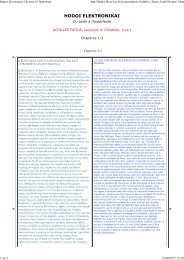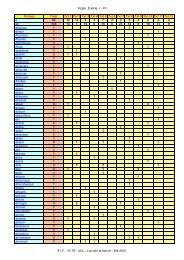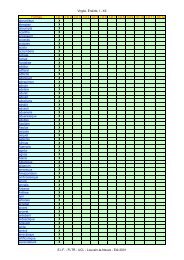The Etymologies of Isidore of Seville - Pot-pourri
The Etymologies of Isidore of Seville - Pot-pourri
The Etymologies of Isidore of Seville - Pot-pourri
You also want an ePaper? Increase the reach of your titles
YUMPU automatically turns print PDFs into web optimized ePapers that Google loves.
292 XIV.iv.28–v.10 <strong>Isidore</strong> <strong>of</strong> <strong>Seville</strong><br />
boundary <strong>of</strong> most <strong>of</strong> it, and which encloses it almost in a<br />
circle.<br />
28. Hispania was first named ‘Iberia’ after the river<br />
Iberus (i.e. Hiberus,the Ebro), later ‘Hispania’ from Hispalis<br />
(i.e. <strong>Seville</strong>). This is the real Hesperia (see section<br />
19 above), named after Hesperus, the evening star. It<br />
is situated between Africa and Gaul, closed <strong>of</strong>f by the<br />
Pyrenees mountains to the north and everywhere else<br />
shut in by the sea. It is temperate in its healthy climate,<br />
abundant in all types <strong>of</strong> produce, and very rich in<br />
its abundance <strong>of</strong> precious stones and metals. 29. Great<br />
rivers flow through it: the Baetis (Guadalquivir), Mineus<br />
(Miño), Iberus (Ebro), and Tagus (Tajo), which carries<br />
gold, just like the Pactolus (see iii.43 above). It is composed<br />
<strong>of</strong> six provinces: the Tarraconian (i.e. <strong>of</strong> Tarragona),<br />
the Cartagenian, Lusitania, Gallicia, Baetica and,<br />
across the straits in Africa, the Tingitanian (i.e. <strong>of</strong> Tangiers).<br />
30.Furthermore there are two Spains: Inner Spain,<br />
whose area extends in the north from the Pyrenees to<br />
Cartagena; and Outer Spain, which in the south extends<br />
from Celtiberia to the straits <strong>of</strong> Cadiz. Inner (citerior)<br />
and Outer (ulterior) aresocalled as if it were citra (on<br />
this side) and ultra (beyond); but citra is formed as if<br />
the term were ‘around the earth’ (circa terras), and ultra<br />
either because it is the last (ultimus), or because after it<br />
there is not ‘any’ (ulla), that is, any other, land.<br />
v. Libya (De Libya) 1. Libya (Libya)issocalled because<br />
the Libs, the African wind, blows from there. Others say<br />
that Epaphus, the son <strong>of</strong> Jupiter and founder <strong>of</strong> Memphis<br />
in Egypt, had a daughter named Libya with his wife Cassiopeia,<br />
and Libya afterwards established a kingdom in<br />
Africa. From her name the land Libya received its name.<br />
2.Further, there are those who think that Africa (Africa)<br />
is named as though the word were aprica (“exposed to<br />
the sun”), because it is open to the sky and the sun and<br />
without bitter cold. Others say Africa is named from<br />
one <strong>of</strong> the descendants <strong>of</strong> Abraham and Keturah, who<br />
was called Afer (i.e. Epher), <strong>of</strong> whom we made mention<br />
above (IX.ii.115). 3. Africabeginsattheborders<strong>of</strong><br />
Egypt, stretching along the south through Ethiopia up<br />
to the Atlas range. In its northern region it is enclosed<br />
by the bordering Mediterranean and is bounded by the<br />
straits <strong>of</strong> Cadiz (i.e. Gibraltar), containing the provinces<br />
<strong>of</strong> Libya Cyrenensis, Pentapolis, Tripolis, Byzacium,<br />
Carthage, Numidia, Mauretania Sitifensis, Mauretania<br />
Tingitana, and Ethiopia under the burning sun.<br />
4. Libya Cyrenensis is in the first part <strong>of</strong> Africa and<br />
is named after Cyrene, the chief city within its borders.<br />
From here Egypt is in the east, the Greater Syrtes and<br />
the Trogodytae (i.e. the Troglodytes) are in the west, the<br />
Libyan Sea lies to the north, and in the south are Ethiopia<br />
and various barbarian nations and inaccessible wilderness,<br />
which also brings forth basilisk serpents. 5. ‘Pentapolis’<br />
in the Greek tongue is so called after its ‘five cities’<br />
(cf. , “five”; , “city”), namely Berenice, Ceutria,<br />
Apollonia, Ptolomais, and Cyrene; <strong>of</strong> these Ptolomais<br />
and Berenice were named after their rulers. Pentapolis<br />
is next to Libya Cyrenensis and is considered to<br />
be within its borders. 6.Intheirowntongue the Greeks<br />
also name a province ‘Tripolitana’ from the number <strong>of</strong><br />
its three great cities: Oea, Sabrata and Leptis Magna.<br />
This province has the Greater Syrtes and the Trogodytae<br />
(i.e. the Troglodytes) to the east, the Adriatic Sea in the<br />
north, in the west Byzacium and in the south the Gaetuli<br />
and the Garamantes, extending to the Ethiopian Ocean.<br />
7.<strong>The</strong> Bizacene region is allotted its name from its two<br />
very famous towns, one <strong>of</strong> which is called Hadrumetum<br />
(perhaps cf. bi-,“two”; ,“yoke, pair”). This region<br />
is located below Tripoli, extending for two hundred miles<br />
or more, rich in oil, and so rich in its soil that seeds that<br />
are sown there return a crop nearly a hundredfold. 8.<br />
Great Carthage is in Zeugis. This is the true Africa, situated<br />
in between Byzacium and Numidia, bounded in the<br />
north by the Sicilian Sea. In the south it stretches as far<br />
as the region <strong>of</strong> the Gaetuli. <strong>The</strong> nearer part <strong>of</strong> it is fruitful,<br />
but the more remote part is filled with wild beasts<br />
and serpents and great onagers wandering in the desert.<br />
Gaetulia is the interior region <strong>of</strong> Africa. 9. Numidia is<br />
so called after inhabitants that wander about far and<br />
wide because they do not have a fixed abode. For in their<br />
language temporary and mobile settlements are called<br />
numidia. Itbegins at the river Amsiga and it marks its<br />
end in Zeugis. East <strong>of</strong> it are the Lesser Syrtes, in the north<br />
the sea that stretches toward Sardinia, in the west Mauretania<br />
Sitifensis, in the south the tribes <strong>of</strong> Ethiopia: it is<br />
aregion <strong>of</strong> very fertile fields. However, in areas covered<br />
by forest it produces wild animals, in steep mountains<br />
horses and onagers. It is also renowned for its excellent<br />
marble, which is called Numidian marble. It has distinguished<br />
cities as well: Hippo Regius and Rusicada.<br />
10. Mauretania is so called after the color <strong>of</strong> the<br />
inhabitants; for the Greeks call ‘black’ . Just as<br />
the name for Gaul is derived from the whiteness <strong>of</strong> its

















